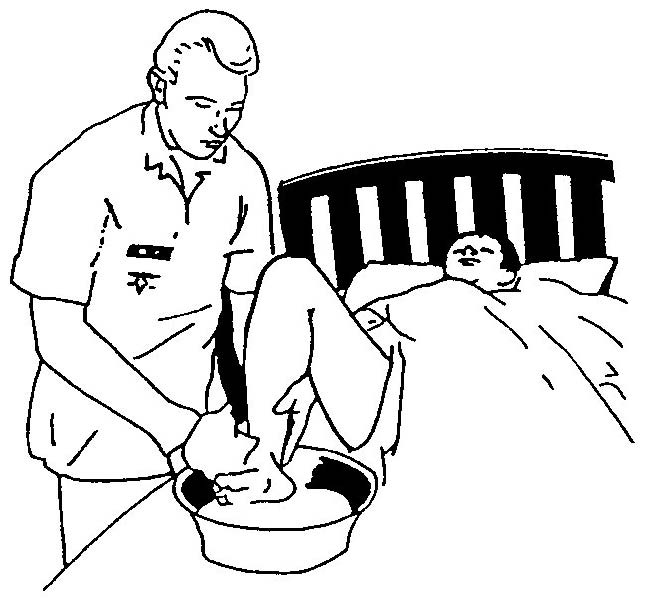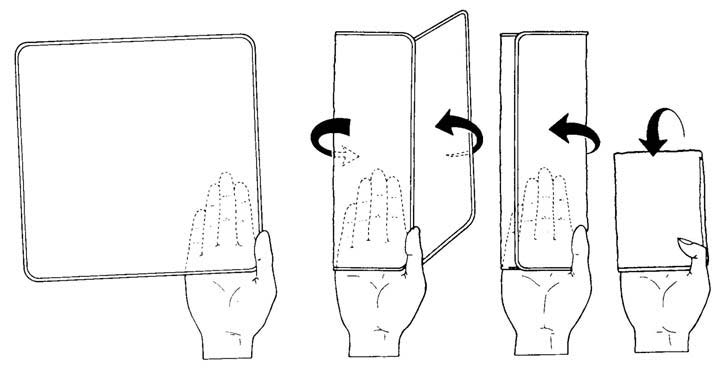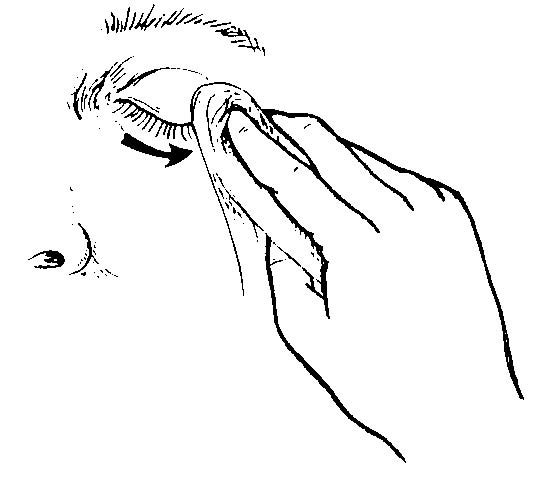 This is the Archived Desktop Edition.
This is the Archived Desktop Edition.
You should be transferred to the Newest Edition for Desktop and Mobile within 2 seconds.
Basic Patient Care Procedures
1-3
1-3. ADMINISTERING A BED BATH/PARTIAL BATH
a. General. When a patient is either confined to bed, must conserve energy, or is helpless, the medical specialist may give the entire bath; however, the patient should do as much for himself as his conditions permit. All necessary equipment is provided and the areas the patient cannot reach are bathed for him. Each bed patient should have his back bathed and rubbed for him.
b. Important Points.
(1) Sometimes a complete bath is too exhausting for a patient. Therefore, a partial bath may be given to include the face, hands, axilla (region under the arms), genitalia, back, and buttocks.
(2) The patient's position during the bath is determined by his physical conditions and his movement abilities. Unless contraindicated (undesirable or prohibited), the bed is level and movement and position change is encouraged. The specialist is encouraged to use good body mechanics and to request assistance when necessary when moving and positioning a patient.
(3) While washing individual areas, the skin should be checked thoroughly for breakdown. During washing, range of motion should be done.
(4) When supporting binders and leg bandages are used, the specialist finds out in advance if they can be removed for skin cleansing, and if they are to be reapplied. The patient receiving a bed bath will often have tubing attachments that must be handled so that they continue to function as he is moved and turned. All tubing must be carefully checked before and immediately after position changes.
(5) Avoid chilling and unnecessarily exposing the patient. Provide for privacy with the compartment curtain or screen.
(6) Change bath water when it becomes cold, dirty, or excessively soapy.
(7) Do not place soap in bath water. Too much suds will prevent adequate rinsing.
(8) Patients with diabetes mellitus will require special foot care.
(9) Expose only those body parts being bathed (figure 1-3).
(10) Don gloves if danger of contact with body fluids exist.
(11) Maintain a neat, clean work area.
Figure 1-3. Bed bath/partial bath.
c. Procedure.
(1) Check the physician's orders.
(2) Visit the patient; introduce yourself and inform him of the procedure. Offer him a bedpan, urinal, or use of bathroom.
(3) Check for the required personal toilet articles and clean linen available in the unit. Clear the top of his bedside cabinet and place the cabinet and chair for optimum workspace. Adjust the room temperature and provide privacy.
(4) Prepare supplies and equipment. The following materials should be assembled:
(a) Washbasin and water (110-115ºF).
(b) Hygiene articles, such as lotion, powder, and deodorant.
(c) Pajamas or gown.
(d) Linen as necessary.
(e) Portable screen as necessary.
(f) Laundry bag or hamper.
(g) Soap and soap dish.
(h) Bath towels (2).
(i) Washcloths (2).
(j) Nail file and comb.
(k) Disposable gloves.
(5) Wash your hands.
(6) Place bath equipment on the cabinet. Place clean linen on the chair in order of use.
(7) Loosen top covers at the foot of the bed. Fold and remove spread and blanket. Leave top sheet for cover.
(8) Lower side rail, position patient on near side of bed, and raise bed to working level.
(9) Loosen top linens from the foot of the bed; place bath blankets over the top linens. Ask patient to hold bath blankets while you remove top linens. If patient is unable, you will have to hold bath blanket in place while removing linens.
(10) Remove the pillow and raise the head of the bed to semi-Fowler's position if patient can tolerate it. Place it at the back of the chair (hang the pillow case to receive soiled linen, if laundry hamper is not readily available). Do not permit soiled laundry to touch your uniform.
(11) Assist the patient with oral hygiene. If the patient is unable, you should perform procedures in paragraphs 1-11 through 1-14.
(12) Remove the patient's gown/pajamas, all undergarments, and jewelry.
(a) If the patient has an injured arm or shoulder, start removing the coat from the uninjured side. When only limited movement is permitted, the pajama coat is worn back to front, and left unfastened.
(b) To remove the coat, unbutton and tuck the excess material under the back toward the far shoulder. Raise the far shoulder, remove the sleeve, and tuck the coat under the near shoulder. Raise the near shoulder and pull the coat through, removing it from the near arm.
(c) To remove the pants, loosen the waist tie, unbutton, and pull the pants below the hips while keeping the patient covered with the sheet. Grasping the waist portion, ease the pants off over the feet.
(13) Wash the patient's eyes and face.
(a) Place the bath towel under the patient's head and the hand towel over his chest. Form a mitt with the bath cloth around hand; ends of bath cloth should not dangle (fig. 1-4). Dip mitt and hand into bath water. Squeeze out excess water.
(b) Bathe the eyelids, using a different portion of the cloth for each eye. Cleanse from inner to outer canthus (corner of eye), as in figure 1-5. Dry thoroughly.
(c) Apply soap to the cloth, unless soap is not to be used on the patient's face. Do not leave soap in water. Rinse bath cloth. Using firm, gentle strokes, wash the face to the hairline. Wash the ears and neck. Use cotton-tipped applicators to cleanse pinna of ear.
Figure 1-4. Mitten washcloth.
Figure 1-5. Bathing the eyelids.
(14) Wash the upper limb.
(a) Remove the bath towel from under the patient's head. Expose the arm farthest from you. Place the bath towel lengthwise under his shoulder and arm.
(b) Wash the arm, using long firm strokes from the wrist to the shoulder. Wash the armpit thoroughly. Rinse and dry. Apply deodorant if applicable.
(c) Fold the towel in half. Place basin on folded towel on the bed; immerse patient's hand in the water. Wash hands and nails while encouraging finger movements. Clean and trim the fingernails as needed.
(d) Remove basin and dry the hand.
(e) Repeat the procedure on the near arm and hand.
(15) Wash the chest and abdomen.
(a) Cover the patient's chest with bath towel; fold bath blanket down to waist; and wash the chest with a circular motion. Be sure to cleanse and dry under breast and skin folds very well.
(b) Fold bath blanket down to pubic area, keeping chest covered with dry towel. Wash abdomen including umbilicus (using cotton-tipped applicators) and skin folds. Dry thoroughly.
(c) Raise side rail; empty basin into hopper or stool. Rinse basin and wash cloth. Refill basin 2/3 full with water at 110º to 115ºF (43º to 46ºC).
(16) Wash the lower limb.
(a) Expose the far leg, draping the sheet securely into the groin and under the thigh. Check to see that genitalia are not exposed when the leg is flexed.
(b) Wash, rinse, and dry the thigh and leg.
(c) Place the basin on a towel on the bed so that the patient's foot can be immersed in the basin with no pressure on the calf of the leg. Wash the foot, paying particular attention to the skin between the toes, at the heels, and at the ankles. Encourage toe and ankle movement. Trim and clean toenails if necessary.
(d) Support the leg at the knee and heel when moving his foot from the basin. Place the basin on the table. Dry the foot thoroughly, rubbing any calloused area with a towel to remove dead skin. Apply lotion to the foot and ankle, massaging the heel in circular motion with the palm of your hand.
(e) Repeat the procedure on the near thigh, leg, and foot.
(f) Change the bath water and rinse the washcloth thoroughly.
(17) Wash the back and buttocks.
(a) Turn the patient to wash his back and buttocks. His position may be prone (on the abdomen) or lateral recumbent (on the side), but the entire back and buttocks should be exposed.
(b) Place the towel close to the back and lengthwise on the bed.
(c) Bathe, rinse, and dry the back from the neck to the sacrum (region in back of pelvis). Pay particular attention to the folds of the buttocks and anal areas.
(d) Rub the back with lotion. Use firm, gentle, circular movements, starting at the base of the spine and rubbing with the heel of both hands, up and out, and over the shoulders. Finish with circular movements at the upper spine and nape of the neck.
(18) Wash the genitalia area.
(a) Turn the patient on his back, to the near side of the bed, and place the towel under his hips.
(b) Hand the patient the prepared washcloth and assist in washing the pubic area and genitalia as necessary. There should be minimal exposure but thorough washing, rinsing, and drying.
NOTE: If the patient has an indwelling catheter, the entire procedure should be done for him
(19) Put pajamas on the patient.
(a) Replace the coat. If the patient has an injured arm or shoulder, start replacing the coat from the injured side. Slip your hand through the sleeve cuff to his
shoulder and grasp the patient's hand. Draw his hand and arm through the sleeve. Now tuck the material under to his other shoulder on the injured side and guide his hand and arm through the sleeve.
(b) To replace the pants, slip your hand through the pant leg from the cuff to the waist and grasp the patient's feet to guide each leg through its pant leg. Raise the patient's buttocks and pull the pants over his hips to the waist. Fasten the buttons and tie at the waist.
(20) Comb the patient's hair.
(21) Remove the bath equipment to the utility room; clean and store it.
(22) Remake the bed. If possible, assist the patient to a chair or stretcher and make the bed as in Lesson 3, paragraph 3-4. If the patient must remain in bed, make it as discussed in Lesson 3, paragraph 3-5.



